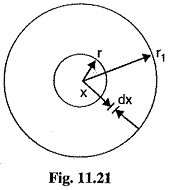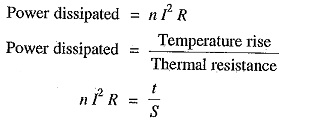Thermal Resistance to Heat Flow:
The Thermal Resistance to Heat Flow between two points in a medium (e.g. insulation) is equal to temperature difference between these points divided by the heat flowing between them in a unit time i e.
In SI units, heat flowing in a unit time is measured in watts.
Clearly, the SI unit of thermal resistance is °C per watt. This is also called thermal ohm.
Like electrical resistance, thermal resistance is directly proportional to length l in the direction of transmission of heat and inversely proportional to the cross-section area a at right angles to that direction.
where k is the constant of proportionality and is known as thermal resistivity.
Thermal Resistance of Dielectric of a Single Core Cable:
Let us now find the thermal resistance of the dielectric of a single-core cable.
Let
r = radius of the core in metre
r1 = inside radius of the sheath in metre
k = thermal resistivity of the insulation (i.e. dielectric)
Consider 1m length of the cable. The thermal resistance of small element of thickness dx at radius x is (See Fig. 11.21)
Thermal resistance of the dielectric is
The thermal resistance of lead sheath is small and is generally neglected in calculations.
Permissible Current Loading:
When considering heat dissipation in underground cables, the various thermal resistances providing a heat dissipation path are in series. Therefore, they add up like electrical resistances in series. Consider a cable laid in soil.
Let
I = permissible current per conductor
n = number of conductors
R = electrical resistance per metre length of the conductor at the working temperature
S = total thermal resistance (i.e. sum of thermal resistances of dielectric and soil) per metre length
t = temperature difference (rise) between the conductor and the soil
Neglecting the dielectric and sheath losses, we have,
Permissible current per conductor is given by;
It should be noted that when cables are laid in proximity to each other, the permissible current is reduced further on account of mutual heating.






